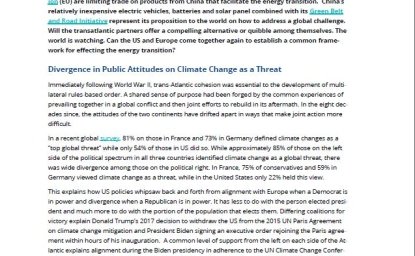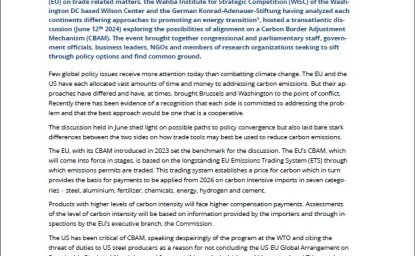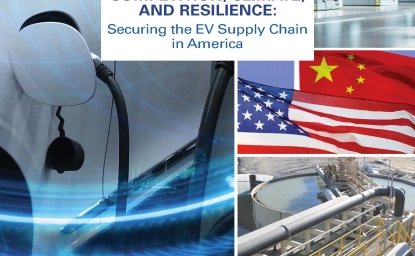Solutions offered to decrease the amount of carbon dioxide in the atmosphere have not put us on a clear path to achieving climate mitigation goals. Greenhouse gas emissions are the result of production, trade, transport, and countless everyday decisions by individuals and businesses. Therefore, achieving a net-zero earth requires attention and innovation at every level. Reaching these goals will require individuals and businesses to make decisions to lower carbon emissions, thus moving the world toward a cleaner future. Carbon measurement can inform and empower the right decisions. You measure what is important to you, and carbon is important.
How carbon is measured is not in question, but the process is tricky. Many governments and organizations are creating their own carbon reporting measures and requirements. Having one uniformly adopted process to count carbon emissions could be less burdensome. Implementing such a system may impose substantial costs at the beginning, but may be worth it in the long run.
The PROVE IT Act (Providing Reliable, Objective, Verifiable Emissions Intensity & Transparency) could be an important tool in implementing a more robust, overarching measurement process. The act is one of the bills on carbon border adjustment mechanisms under review by Congress. The Act proposes making a study of all carbon dioxide emissions from goods made in the US, and goods made overseas, and then comparing them. The report that would come out of this study could inspire a new, uniform process of implementing standard carbon measurement regulations that are consistent across the global market. The task is difficult, but doable.
Carbon accounting, an ambitious alternative to The PROVE IT Act, is another way of measuring carbon. A global carbon counting system, where every molecule of CO2 created during the production process is counted and made publicly available, could incentivize companies to invest in cleaner production processes. If consumers knew the difference in carbon emissions between two similar products, many would likely purchase the product that is better for the environment.
If both are implemented, they could complement each other. The carbon accounting system would meticulously track every molecule of CO2, while the data generated would enhance the study outlined in The PROVE IT Act, providing more accurate and comprehensive calculations. Given that both are significant undertakings, with carbon accounting being more complex than the two, implementing The PROVE IT Act would be less daunting and should take priority. Either approach would help advance climate mitigation goals.
By implementing a universal carbon-counting system or adopting policies such as The PROVE IT Act, the US can leverage carbon measurement to lead global initiatives toward a cleaner, net-zero future.
Solution 1: Carbon Intensity Measurement
There is a bipartisan bill that calls for a study of the relative emissions intensity of traded goods produced in the US and abroad. The PROVE IT Act, introduced by Senators Coons and Kramer in 2023, passed the Senate Environment and Public Works Committee on a 15-4 vote. The PROVE IT Act would direct the Department of Energy (DOE) to conduct a study of greenhouse gas emissions intensity of certain products produced in or imported into the US. The Secretary of Energy would be required to submit a report on the greenhouse gas intensity of products. The first report would be due within the first two years of the bill being enacted, with additional updates required every five years.
The study would identify the average emissions intensity of covered products produced in the US or by a foreign partner. Further, it would compare the emissions intensity of each covered product in the US to the emissions intensity of similar, unregulated products from other countries. In the bill, covered products include aluminum, iron and steel, cement, plastic, biofuels, crude oil, fertilizer, and refined strategic and critical minerals.
The data gathered from The Act would encourage and facilitate public entities and private groups (such as the Department of Energy and Climate Leadership Council) with expertise in data collection and analysis to support international coordination on emissions intensity data. By determining the emissions intensity of goods produced domestically compared to those produced internationally, the US could show that it is a leader in pioneering clean energy and spur other countries to follow its lead.
This information could also form the basis for a carbon border adjustment, which would apply fees to imported goods based on how much greenhouse gas emissions were generated during their production. The effect of such a border adjustment would be to disadvantage porducts with greater carbon intensity, like those from China and Russia.
Carbon intensity measurement is a way to compare the emissions intensity of internationally traded goods. It could show the countries with the highest levels of emissions in their traded products. By having the data collected and re-analyzed every five years, it offers continual reporting to ensure progress on reducing emissions.
Solution 2: Carbon Accounting
When GAAP (Generally Accepted Accounting Principles) was created in 1935 in response to the stock market crash of 1929, it established a universal set of accounting principles to ensure consistent and accurate financial reporting. From 1935-40, leaders in policy and business established system-wide accounting measures that have largely been adopted globally. Having a common, trusted measurement of economic activity has been foundational to global growth ever since. To reduce carbon, we need new processes to measure the total amount of carbon dioxide emissions for every product made. Counting and documenting CO2 emissions from the production of goods worldwide can provide a path for reducing them.
Firms already consider time, cost, quality, etc., when calculating the total expenses of making a product. If something is important, such as carbon dioxide emissions, it too should be measured. Therefore, the amount of carbon dioxide being emitted during production should also be quantified when calculating total expenses.
Carbon counting can incentivize firms to reduce greenhouse gas emissions by accurately and reliably measuring the amount of CO2 released from producing and selling products. This counting system would require all supply chain actors to measure the direct emissions created, collect material emissions from suppliers in all purchased units, allocate the sum to their products, then transfer to customers, and report emissions released from cradle to grave. Doing so could encourage consumers to be climate-conscious about decisions, producers to compete with lower-emission value propositions, and investors to supply lower-cost capital to those producers with winning technologies. This could bring us closer to reaching the 1.5°C goal outlined by the Intergovernmental Panel on Climate Change (IPCC). This goal, introduced in 2015, aims to limit the global temperature increase to 1.5°C above pre-industrial levels. By reducing emissions to meet this objective, the world has a better chance of reaching net zero.
Integrating the measurement of CO2 emissions with existing performance metrics could also encourage technological innovation. When consumers compare different products and can see the carbon dioxide emissions associated with each, they are likely to choose the environmentally friendly option, assuming all other factors are equal. Therefore, companies would compete to produce the lowest carbon emissions on their product, stimulating innovation in clean energy.
The US often takes a top-down approach to addressing climate change by relying on policies and regulations to establish the framework for nationwide climate mitigation strategies. Although some policies have successfully reduced emissions, most don’t make that large of an impact. This is mainly because they are too specific. Politicians are looking for a one-size-fits-all solution with legislation, but this does not work across all sectors. A bottom-up approach would be best suited to the American economy, and it is more palatable than legislation.
A bottom-up approach is a market-driven approach and influences policy through behavior (instead of the other way around). People mostly cut back on emitting carbon dioxide when it affects their wallets. When it does, it can lead a nationwide movement and be more effective than legislation. The climate crisis can be best addressed if Americans collectively make subtle behavioral changes such as using public transport more, limiting energy use, and buying products that have emitted the least amount of carbon dioxide in their production. Together, the government and the market can make the public more climate-conscious. Governments implementing successful policies aimed at overall greenhouse gas emissions reductions and markets competing to have the lowest emissions-producing products could make the US a world leader in decarbonization.
Would China and Russia also adapt similar carbon reporting? A carbon border adjustment could be crafted in a way that encourages reporting. Another encouragement could be international investors prioritizing such reportings in their investment criteria.
Even though carbon accounting may not be initially uniformly adapted, it is one alternative to the PROVE IT Act. Decarbonization is essential for the future of the planet. To reach net zero and to achieve climate mitigation goals, encouraging bottom-up innovation is essential. It starts with counting carbon. Climate change is the result of billions of commonplace everyday decisions that people, organizations, and governments make. Therefore, a bottom-up, market-driven approach in which behavior influences policy can play to America’s strengths as a free-market society. By implementing these carbon measurements, we can begin to achieve the goal of not raising global average temperatures past 1.5°C.
Author


Wahba Institute for Strategic Competition
The Wahba Institute for Strategic Competition works to shape conversations and inspire meaningful action to strengthen technology, trade, infrastructure, and energy as part of American economic and global leadership that benefits the nation and the world. Read more







